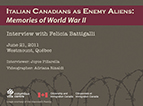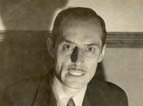Fascism in Canada
I don’t think that they really believed it. I think they just joined an organization … the fascists from Saint-Henri, ninety percent of them were not educated. I think it offered them somewhere to go for a meeting, to get-together, to play cards, to have a drink and talk about their home.
Joe Mastromonaco, son of internee Giovanni Mastromonaco, video interview, Columbus Centre Collection
I swear to execute without discussion the orders of il Duce and to serve with all my strength and if necessary with my blood the cause of the Fascist Revolution.
The oath that appeared on fascist membership cards, RCMP, The Organization and Activities of the Italian Fascist Party in Canada, Library and Archives Canada
I mean, [my grandfather] was proud of Victor Emmanuel. He also believed in what Mussolini was doing for the Vatican and bringing back the states to Rome, which had been confiscated. And that was one of the reasons why he supported them and I know that they had collected all their jewellery and sent it over to Italy to help Mussolini and his endeavour. And I don't think ever, ever, ever that my grandfather had anything against England or Canada.
Sandy Corbo, granddaughter of internee Achille Corbo, video interview, Columbus Centre Collection
The meaning of fascism varied for Italian Canadians. Some wore black shirts and were active in a local fascist group known as the fascio. They believed in the political philosophy and supported Italian state interests in world affairs. Others responded to the positive change they felt Mussolini was bringing to Italy – political and economic stability, including infrastructure projects and increasing agricultural output. Among devoted Catholics, Mussolini was also praised for the Lateran Accords.
Italy’s fascist government considered all emigrants as Italian citizens whether or not they had become naturalized in other countries. Due to this policy, Italian consuls and vice-consuls in Canada, actively courted the community, promoting an Italian identity based on fascist propaganda and culture. This included the purchase or construction of buildings called Casa d’Italia and supporting the pro-fascist press in Canada, both financially and editorially. The consuls and vice-consuls also oversaw the Gioventù Italiana del Littorio Estero (Italian Lictor Youth) and the Dopolavoro.
Fascism was not exclusive to Italian neighbourhoods. During the 1920s and 1930s, fascist organizations existed among English, French, and German Canadians. The most well-known fascist leader of the time was Montreal’s Adrien Arcand of the National Unity Party (NUP). Arcand and members of the NUP were also interned during World War II.



